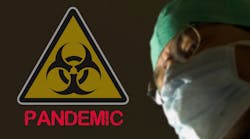U.S. hospitals prepare for Covid-19
When Ebola reached U.S. shores in 2014, healthcare workers and experts were not ready for a major infectious disease outbreak—and promised themselves that next time, they would be. Now that the next crisis has arrived in the form of the novel coronavirus disease (COVID-19), experts look at exactly how ready are U.S. hospitals.
"We often talk about a panic/neglect cycle," said Eric Toner, MD, a senior scholar at the Johns Hopkins Center for Health Security. "Every time there's a crisis, people get into panic mode and there's a lot of intense response for a short amount of time. Then the crisis passes and no one pays attention until the next crisis."
As the challenges specific to this virus begin to emerge, experts say hospitals are—or should be—preparing for a surge in patients, training healthcare workers in the proper use of personal protective equipment (PPE), and coordinating with public health officials on testing procedures.
The SARS (severe acute respiratory syndrome) epidemic of 2003 offers perhaps the best lesson for hospitals, Toner said, "The greatest risk is from an unsuspected patient in an unprepared hospital."
More recently, the Ebola scare underscored the need for streamlined communication and collaboration, something not easy to accomplish in the disjointed U.S. healthcare system. To address that need, the U.S. Department of Health and Human Services (HHS) and the Centers for Disease Control and Prevention (CDC) formed the National Ebola Training and Education Center (NETEC) in 2015. Led by three organizations that successfully treated Ebola patients—Emory University, the University of Nebraska Medical Center/Nebraska Medicine and the New York Health and Hospitals Corporation, Bellevue Hospital Center—NETEC now offers hospitals centralized knowledge: resources, including education and training; readiness consultations; and a research network that can fast-track studies through its own institutional review board.
HHS also created a network for future infectious disease outbreaks, designating 10 hospitals as regional special pathogen treatment centers. Not only are those 10 frontline hospitals better prepared for an outbreak, but they educate other hospitals between outbreaks, said Courtney Gidengil, MD, MPH, a senior physician policy researcher at the Rand Corporation who co-authored a report on hospital readiness for infectious disease outbreaks in 2018.
That report applauded those efforts, but also recommended steps to strengthen and build on them and formalize networks, since the degree to which the more than 5,000 U.S. hospitals use those resources varies. Also, which hospital a patient with Covid-19 presents to is completely random: there's no path to direct a patient to a hospital that's particularly well prepared, Gidengil said.
Ideally, said Paul Biddinger, MD, chief of the division of emergency preparedness at Massachusetts General Hospital, the Region 1 regional special pathogen treatment center, each hospital would be prepared now to treat a patient having Covid-19 symptoms like this:
· As soon as someone walks into a hospital, signage, questionnaires, and prompts in the electronic health record would be in place to ask about possible symptoms and exposure to the Covid-19 virus. Once the person is suspected of having Covid-19, that patient would be given an N95 respirator and placed in an isolation room.
· Then, only staff who have been trained in proper protocols for donning and doffing PPE—likely from the emergency department—would provide clinical assessment and care. If the patient's symptoms warrant testing, the hospital would contact the state public health department. If health department experts agreed with the need for testing, they would contact the CDC. The hospital would send the sample to the state, and the state would pass it on to the CDC.
· If Covid-19 patients are generally well, they could be isolated at home and carefully monitored by public health officials. If they need to be hospitalized, they would need to be in an airborne infection isolation [AII] room with trained staff and overall guidance to manage visitors and items entering and leaving the room.
"They need to manage as though they are infected until we know they are not," Biddinger said. It's still unclear exactly how contagious Covid-19 is, but experts say it transmits similar to the flu, and it has spread rapidly in China and appears to be escalating in Singapore. Especially if patients continue to need isolation rooms, hospitals could quickly get overwhelmed, Biddinger said.
Even the regional hubs, which are required to have at least 10 AII rooms, would be hard-pressed to treat masses of patients with Covid-19 simultaneously. Some hospitals have the ability to turn an entire floor or wing into a negative-pressure area, Biddinger said, but that produces other challenges, such as requiring healthcare workers to wear PPE the entire time they're in the space, and the ability to make a definitive diagnosis before a patient enters the area. It also displaces the patients who had been housed in that section.
"If we start to see large numbers of patients presenting for diagnosis or who need hospitalization or intensive care, we already operate at full capacity or beyond, so it's extremely challenging to change quickly and make sure we can provide safe care for everyone," Biddinger said.
Now, with more than 1,700 healthcare workers infected in China, experts are reminding hospitals that training staff on proper protocols could be critical in preventing Covid-19 spread in healthcare settings.
Even though healthcare workers should be relatively familiar with the PPE, including N95s, Gidengil said, healthcare facilities should be fitting the respirators, offering refreshers on donning and doffing, and reviewing best practices.
Over the past five years, Mass General has developed a toolkit of plans, protocols, exercises and videos for various diseases requiring different types of PPE "We've pushed that out across the entire region to help other hospitals get ready faster," Biddinger said.





